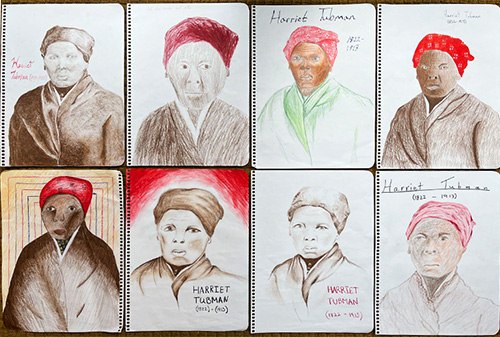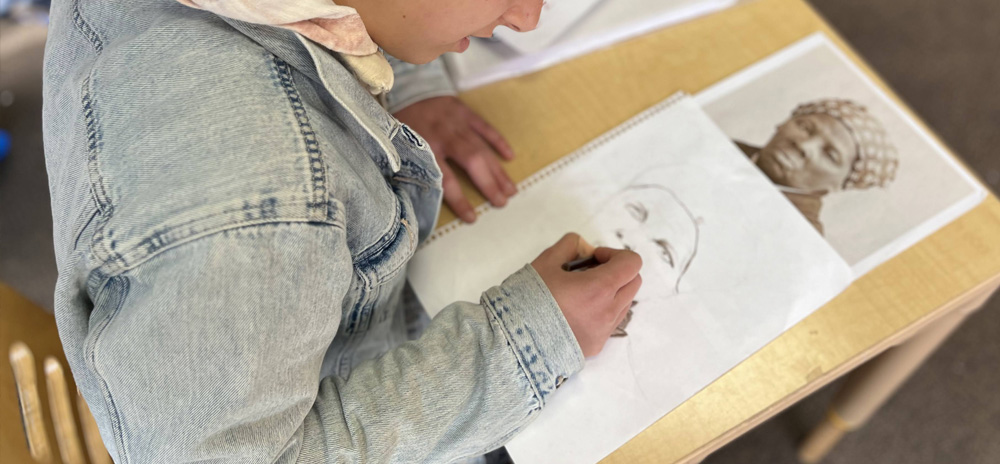||| Berkeley Rose Waldorf School celebrates and honors the rich history of Black culture throughout the year. This February the school took time to highlight and share uplifting and true stories of African, and African American History and Culture to further honor the importance of Black History Month. Below are collections of the school; Kindergarten through Eighth grade.
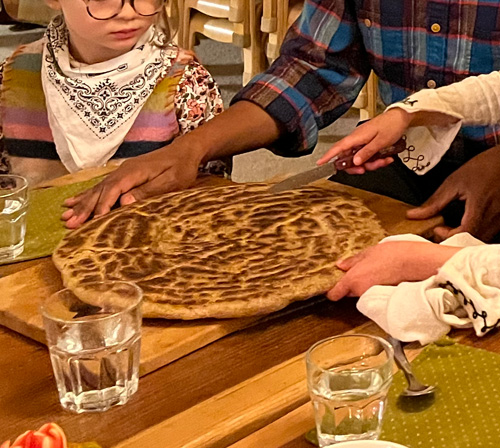
Kindergarten
Our Kindergarten classes had the privilege of having a special visit from Grandma Lucia and Papa Rez. They shared with us food and some customs from their home country, Eritrea. Grandma Lucia woke at 3am for us to make sure the dough was prepped and had risen to make the traditional bread, himbasha on the mogogo (a large griddle) which she brought in for us to see and use! We also learned a clapping game, “Endendino.” The class had been practicing how to say, Yegeniyeley, “Thank you” in ትግርኛ (Tigrinya). We enjoyed the himbasha served with honey and every last piece was eaten.
Immense gratitude to our Kindergaten family who so generously shared some of their culture with the Sunflowers. Yegeniyeley!
This month we also had an activity of paper weaving “heart garden baskets” of different skin tones, along with the Ethiopian story of “The Perfect Orange”, in which an orphan child gifts the King with a simple orange and refuses payment. She does however accept a donkey unaware its saddlebags are filled with gold.
Our Kindergarten teachers also embarked on a rich cultural journey that included attending a traditional Gambian band concert from the Gambian Griots over February break at Ashkenaz in Berkeley after an invitation from Teacher Medina. We were mesmerized by the beautiful and captivating sounds of the Kora instrument and danced along to the music.
In our other Kindergarten classroom, the children were engrossed in a story written by teacher Medina about her ancestors in The Gambia, her place of origin. The story vividly portrayed scenes from the people, culture, and natural environment of The Gambia. It introduced us to two children, Fatou and Lamin, and their adventures in the village of Tankura. The narrative painted a picture of the birds, animals such as monkeys, crocodiles, goats, and fish, as well as the Millet fields and presented us a traditional dish called “Chakry”, made with couscous and sour yogurt. To our delight, teacher Medina even offered us a taste of this delicious dish as our dessert on Soup Day.
Additionally, we were treated to the song “The offerings to the Big Crocodile,” and the children were captivated by the enchanting African tune. We felt fortunate to experience this immersive journey into African culture and heritage, guided by teacher Medina, who shared a glimpse of her roots with us. Thank you dear teacher Medina! Abaraka! Jerre Jeff!
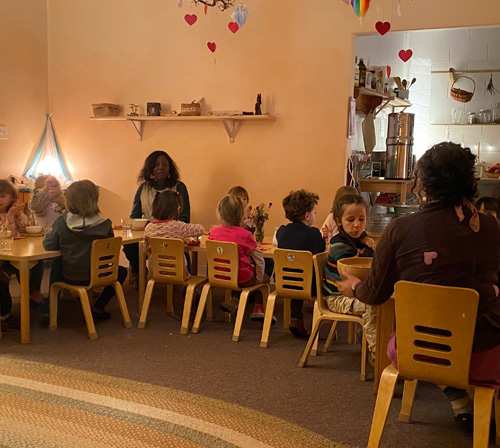
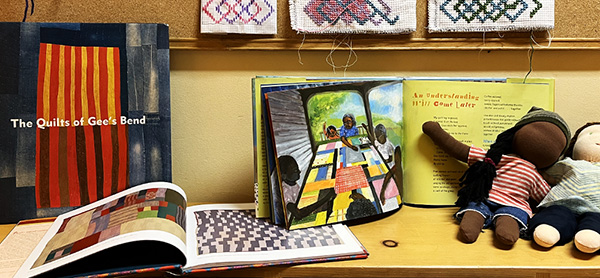
Handwork
In First and Second Grade, a book was read, titled “Stitchin’ and Pullin’ ” by Patricia McKissack and Cozbi A. Cabrera. This is a historically accurate tale told through the lens of a young African American girl as she grew up in Gee’s Bend Alabama, with generations of women in her family quilting out of necessity and those quilts later becoming heralded as works of art.
In Third Grade a book of these quilts of Gee’s Bend was brought under the perspective of living art and appreciation of how the materials were made, preserved and revered.
In Eighth Grade a deeper conversation was had in regards to the history of the folks of Gee’s Bend. How the people, who were once slaves, stayed near where they were enslaved, worked the land, were downtrodden by local governance and then made the blankets out of necessity. The quilts are now sought after pieces of fine art, which lead to the ultimate art curation in 2002. The art collection traveled all over the United State. To bring this topic to the present, this last month, Target (the nationwide department store) sold items of clothing and other home goods inspired by Gee’s Bend unique and distinct styles.
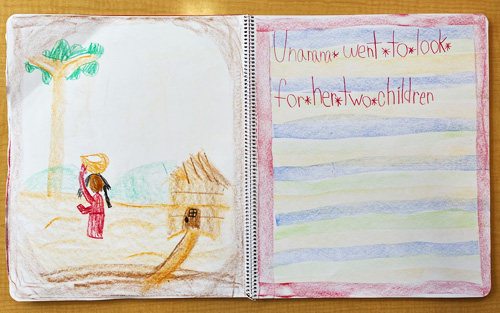
First Grade
Students in First Grade heard folktales from Africa and the Caribbean, drew African landscapes and wrote about the stories they heard.
The stories were:
‘Unanana and the Elephant’ from Tatterhood, Feminist Folktales from Around the World by Ethel Johnston Phelps, and
‘Spider Drummer a Folk Tale from Jamaica adapted for puppetry from Multicultural Stories, collected, adapted and written by Suzanne Down
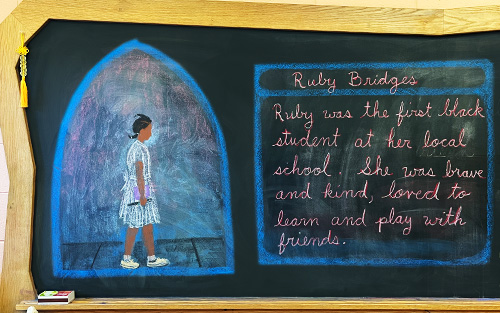
Second Grade
In honor of Black History month the Second Grade started their Saints and Holy People Block with the story of Ruby Bridges, a very brave girl who was the first black student to attend her local school. We wrote about Ruby and drew a picture of her and read the children’s book that she wrote. The children noticed how happy and kind she looks now and in the past. Inspired by her story the students wrote their own short story about helping others, and spoke about how to look for opportunities to be kind.
Third Grade
Black History Month occurred during our Fiber Block which offered us the opportunity to learn more about an important fiber: Cotton. Third Grade discussed the importance of cotton over the centuries and that, up until only the last century, it was produced from the hard work and lives of slaves. We heard stories and since the beginning of the school year have sung African American spiritual songs. The 3rd graders also got to see and appreciate the artistry of this community in the colorful quilts that are now featured in museums and books.
Fourth Grade
As part of their California History block, Fourth Graders will hear about Black men and women who explored the western continent during the days of the fur trade. They will read excerpts of the diary of Joseph Loper, a sixteen year old Black cowboy. Mr. Simpson, our beloved Games teacher, will come in to share his family’s California story.
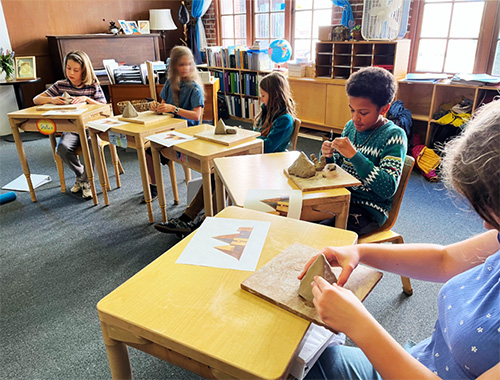
Fifth Grade
In Fifth Grade, students were brought weekly nuggets of Black History and achievement including: a poem by Langston Hughes for recitation, a lesson on the ancient kingdom of Kush with clay sculpting of a Kushite pyramid, mini-bios of Black astronauts Mae Jemison and Jessica Watkins as part of a math lesson on measuring vast distances in space.
Sixth/Seventh Grade
The Sixth/Seventh Grade read through Dr. King’s famous “I have a Dream” speech. We took turns reading it aloud and then we discussed it within the context of the time it was delivered. This sparked a lively conversation about how things have changed for black people since then, versus how things may have not changed since then. Overall, the students took in the entire speech with grace and understanding, and enjoyed contemplating its meaning and relevance in today’s world.
Eighth Grade
Black History Month happened to coincide with our modern history block in Eighth Grade. We began by talking about human rights in general. After brainstorming a list of things people have fought for in different times and places around the world, the students created a timeline of key events in human rights history. Through the biography of Harriet Tubman, we then focused in on the Civil War and Reconstruction eras. Simultaneously, we read Freedom’s Children, a collection of anecdotes from young people who took part in the Civil Rights movement of the 1950s and 1960s. These stories helped the students make connections between past and present, from slavery to the right to vote, from Black is Beautiful to Black Lives Matter. Our block also included recitation of poetry by Maya Angelou and singing of songs from the Civil Rights movement.
